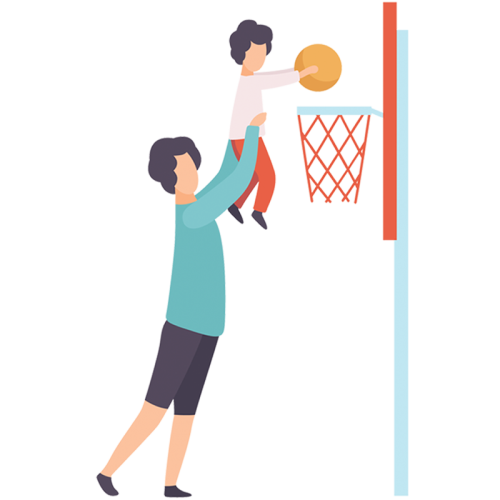Catch Them Being Good
Children will naturally do things that are most likely to get attention, so it makes sense to direct your attention to behaviors that you want to see.
Goal

Overview
Children will naturally do things that garner attention. The things they do can be wanted behavior (good things you want your child to do) or unwanted behavior (misbehavior and acting out). Unfortunately, wanted behaviors don’t always draw enough attention – parents may start to expect them and fail to acknowledge them when they do. In other words, parents may see them as things that their child should just do because they are the “right” way to behave. However, even negative attention is better than no attention for most kids, so they often turn to unwanted behaviors to get their parents’ attention. This program will help you return focus to wanted behaviors, and reduce the need to discipline unwanted child behavior.
Method

Define the "wanted" behavior.
One of the hardest things about catching them being good is that parents often don’t notice wanted behavior. This can be a little easier if you have a working list of wanted behaviors that you plan to catch.
Here are some suggestions to help create your list:
Opposite of unwanted behaviors.
What do you not want your child to do? Think of the opposite. Unwanted behavior could be minor annoying behavior (making strange noises) or more problematic behavior (tantrums). If your child colors on the couch, what would you rather them do? They could color in a coloring book or read on the couch. Both are wanted behaviors that might otherwise go overlooked.
Expected behavior.
Expected behaviors are things that you expect your child to do; they’re not extraordinary behaviors, but they are things that you should recognize and encourage. These could include things like: doing homework, closing the door, turning off the light when leaving the room, putting away a toy, holding your hand when crossing the street, saying “thank you,” following a direction, and so on.
Nice-to-have behavior.
Wanted behavior could also include actions that are “nice to haves” such as doing something without being asked or told, saying something kind, etc. However, remember that the main goal is to includes a lot of everyday behaviors to reinforce that your child is already doing well, so you should not only focus on nice-to-have behavior.

Set them up for success.
The easiest way to ensure you will catch wanted behavior is to pay attention when your child is in a stress-free situation. Think about the times when your child is happiest—for example, playing with their favorite toy. When you start this program, try to plan around times that you know your child is most likely to demonstrate a lot of wanted behavior.

Catch them!
When you see a wanted behavior, make sure your child knows you have seen it and that you approve. Remember that wanted behavior can be anything your child is doing that is NOT unwanted, so you should have ample opportunities to catch them.
Vary how you catch good behavior.
It can be done enthusiastically with a big smile and excited praise, or subtly with brief eye contact and a knowing, approving smile. How it is done is not nearly as important as making sure your child understands that this is a wanted behavior, that you recognize their good action, and that you approve.
You can also tell them exactly what they did that got your attention.
“Wow! I love how you put that toy away without me asking!”
Affectionate touch can also go along with your attention and specific praise, such as a quick hug, gentle squeeze of the shoulder, or any brief loving and encouraging touch that feels comfortable for you and your family.
Catching them while playing
Harry and Sutton are building blocks together. Watch how their mom “catches” their good behavior. Notice that they are not doing anything extraordinary —they are just building blocks without any fighting or arguing. These are some of the most important behaviors to catch!
Challenges
I am not seeing any wanted behavior to “catch.”
Review Step 1: Defining the wanted behavior. Are your expectations too high? Are you trying to catch the every-day behaviors or are you only focusing on extraordinary behavior? Wanted behavior can be really small things, and that is okay! As you get better at catching them and they learn what type of behavior gets your attention, you’ll start to see more wanted behavior!
I reviewed Step 1, and I am still not seeing enough wanted behavior.
Go back to Step 2: Setting them up for success. Think about times when your child is most happy. These are the times you are likely to see lots of wanted behavior. Focus on these until you and your child get used to it.
My child does not seem to care about my attention.
Change up how you give the attention. Not all kids respond the same way to all attention. You could try using silly voices or making exaggerated facial expressions. You could also try to change up what you say so that you are not repeating the same phrase (like “good job!”) over and over. One strategy is to go through the alphabet for your praise phrase (e.g., Awesome work, that was Beautiful!, you are a Champion). Kids also love when they really wow their parents—try acting like you cannot believe what they did, such as saying, “Oh my goodness! How did you know to put that toy away?! I bet you can’t do that again!!”
I've tried different types of attention, and my child still does not seem to care about my attention.
If you have really worn out all types of attention, you can consider using other rewards occasionally. Other rewards could include small toys, time with electronics, special trips, or privileges. Rewards should only be given occasionally. Continue to praise wanted behavior every time you catch it, and randomly (maybe for every 10-20) reward one with a prize. Refer to Picking Rewards that Work and How to Set Up a First-Then Reward System for more tips on using rewards.
Practice

Prepare
Pick a time when your child is happy and calm to watch them.

Apply
Watch your child for about 10-15 minutes. Whenever you see a wanted behavior, catch it!

Repeat
Practice at least once a day or as often as you can. Aim to catch wanted behavior at least 10-20 times a day.
Next Steps
The next steps involve adding in challenges so your child has the chance to be caught for making a good choice and to use naturally occurring opportunities to catch good behavior (more on both below). In this video, watch how Harry and Sutton are asked to clean up. This could be an opportunity to catch them being good! See what happens.
Introduce challenges.
After this program has been in place for at least two weeks—or after you notice an increase in wanted behavior and a decrease in unwanted behavior—you can introduce some challenges. Challenges are situations that, in the past, may have led to unwanted behavior. As an example, give a very simple instruction at a slightly inconvenient moment. If the instruction is followed, encourage it with your positive attention. If it is not, refer to strategies to follow through on instructions.
Capitalize on natural challenges.
Sometimes challenges come up naturally. For example, another child takes a toy from your child. Watch these episodes carefully. If your child does anything you consider appropriate (e.g., picks out another toy, calmly asks the child for the toy back), quickly praise the child and make sure your child knows what you are praising (“You used really nice words when you asked Jake to give you the car back! I am so proud of you.”). If the situation involves someone else (as in this example), you can also help the child navigate the situation—for example, can they play with the toy together? Can they take turns? This is also an opportunity to catch the other child doing what you want. If the child gives the toy back without a fuss, this too should be praised.
